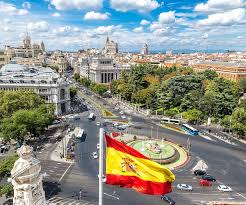Spain is a country located in extreme South-western Europe. Spain shares a border with Andorra, France, Gibraltar, Portugal, and Morocco. The coastlines include Bay of Biscay, Mediterranean Sea, and North Atlantic Ocean. It occupies about 85% of the Iberian Peninsula sharing with neighbor Portugal. Spain governs the number of territories in modern Morocco including many enclaves and Canary Island. The people of Spain are known as Spaniards using Castilian or Spanish language to communicate. Spain is spread over more than five hundred thousand square kilometers of land with almost 50 million people residing in Spain. The country is divided into 17 autonomous communities having its own government.
The country is geographically and culturally diverse. The Northeast part of the country is  the broad valleys of Ebro River, the mountainous region of Catalonia, and the coastal plains of Valencia. To the north-east part, there is the Cantabrian Mountains, heavily forested rocky range, with disposed of rain-swept valleys having tall peaks. To the south of the country there are citrus-orchid-rich and irrigated lands of valley of Guadalquivir River and over this valley rises the snow-capped Sierra Nevada. Southern Spain is a desert and extension of Sahara. The south-Eastern is Mediterranean Coast and the Balearic Islands lined with palm trees, rosemary bushes, and other tropical vegetation which relish gentle climate, attracting millions of visitors from Northern Europe.
the broad valleys of Ebro River, the mountainous region of Catalonia, and the coastal plains of Valencia. To the north-east part, there is the Cantabrian Mountains, heavily forested rocky range, with disposed of rain-swept valleys having tall peaks. To the south of the country there are citrus-orchid-rich and irrigated lands of valley of Guadalquivir River and over this valley rises the snow-capped Sierra Nevada. Southern Spain is a desert and extension of Sahara. The south-Eastern is Mediterranean Coast and the Balearic Islands lined with palm trees, rosemary bushes, and other tropical vegetation which relish gentle climate, attracting millions of visitors from Northern Europe.
Spain always had a parliamentary system with a written constitution except for the First  Republic, Second Republic, and the Spanish Civil War where Spain has a monarchy system. The Spanish constitution with one accord was approved by both the houses of Legislature in 1978. The constitution declares that Spain is Constitutional Monarchy and patron the essential values of freedom, equality, justice, and political pluralism. It also has a separation of powers into executive, legislative, and judicial branches. Despite the fact that monarch the head of state and highest representative in international affairs, its role is confined and neutral. Although the monarch is also the commander-in-chief of armed forces without actual authority over them.
Republic, Second Republic, and the Spanish Civil War where Spain has a monarchy system. The Spanish constitution with one accord was approved by both the houses of Legislature in 1978. The constitution declares that Spain is Constitutional Monarchy and patron the essential values of freedom, equality, justice, and political pluralism. It also has a separation of powers into executive, legislative, and judicial branches. Despite the fact that monarch the head of state and highest representative in international affairs, its role is confined and neutral. Although the monarch is also the commander-in-chief of armed forces without actual authority over them.
Ethnic Groups of Spain
Spain has been inhabited by many different ethnic groups. The Peninsula was originally settled by people from North Africa and Western Europe including Celts, Basques, and Iberians. Throughout the ages, the peninsula was a persistent point of attraction from civilizations of the eastern Mediterranean. Outsiders like the Greeks, the Phoenicians, the Carthaginians formed a variety of people collectively known as Iberians with different cultures and different languages. The ethnic group of Spain includes the Romans, the Visigoths, the Muslims, and the Gitano.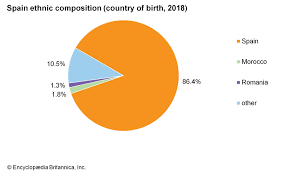
Traditional Outfit of Spain
Spanish fashion is very modern but traditional Spanish clothing is worn for special events and celebrations. Although the traditional Spanish clothing is reserved for special occasions but most common pieces are still used today like the Mantilla, The Peineta, and the Gilet.
- The Mantilla is a traditional Spanish veil frequently worn during religious celebrations like Spanish weddings. It is a Silk scarf that is worn over the head on a high comb.
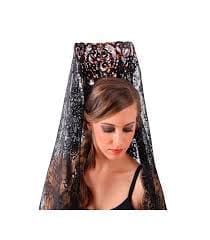
- The Peineta is a decorative comb place in the hair to set back the Mantilla. It is designed as a tortoise-shell colored with the cut body and long spikes to increase the height. It is used on special occasions making it a traditional piece of Spanish clothing.
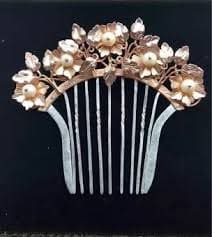
- The Gilet is a sleeveless jacket like a waistcoat that constitutes an important part of traditional Spanish clothing. Historically they were fitted and embroidered. Contemporary gilets are used for additional warmth outdoors.

Apart from the Spanish typical outfit, there are other regional Spanish clothing yet to become famous. These clothing form an important part of Spanish culture with each attire having a complex mixture of Roman, Arab, Latin, and Berber fashions.
- Traje De Flamenca – (Andalusia Community)

Flamenca outfit is designed to be worn by women at festivals in Andalusia. There are two versions of Flamenca outfit- one is the traditional dress worn by Flamenco dancers and others as a regional daily dress. The regional outfit is popular for being colorful and graceful. Outfit includes skirt, and sleeves that have flounces which are either plain or patterned with Polka dots. The dress also includes a shawl that is worn by the woman over their shoulders and decorative comb in their hairs.
- Fallero and Fallera ( Valencian community)
The traditional outfit of the Valencian community differs according to the area and city. In Valencia, Traje De Fallera for women and Traje De Torrential for men is very popular. These outfits are worn during the festival of Las Fallas celebrated in March. It was a typical work dress of female town’s farmers but after years it became an outfit for important occasions. Dess includes a long skirt, a bodice, and lace apron. The footwear generally matches the fabric of the skirt and bodice. The most attractive feature of fallera outfit is a hairstyle where falleras wear a large bow decorated with a big comb at the back and two little bows at both sides of the head known as a rodetes.
Valencia, Traje De Fallera for women and Traje De Torrential for men is very popular. These outfits are worn during the festival of Las Fallas celebrated in March. It was a typical work dress of female town’s farmers but after years it became an outfit for important occasions. Dess includes a long skirt, a bodice, and lace apron. The footwear generally matches the fabric of the skirt and bodice. The most attractive feature of fallera outfit is a hairstyle where falleras wear a large bow decorated with a big comb at the back and two little bows at both sides of the head known as a rodetes.
- Chulapo and Chulapa (Madrid)
The traditional outfit in the Madrid region is Traje De Chulapo for men and Traje De Chulapa 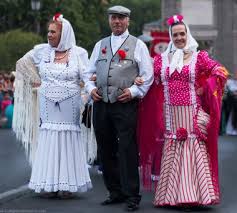 for women commonly worn during the San Isidro celebration. The chulapa dress includes a white blouse with Lantern sleeves, a Polka Dot skirt, a headscarf with two carnations, and Manila shawl over the Shoulders. The chulapo dress comprises of a narrow short jacket with a carnation on the lapel, dark tight trousers, black or grey cap, low boots, and white neckerchief.
for women commonly worn during the San Isidro celebration. The chulapa dress includes a white blouse with Lantern sleeves, a Polka Dot skirt, a headscarf with two carnations, and Manila shawl over the Shoulders. The chulapo dress comprises of a narrow short jacket with a carnation on the lapel, dark tight trousers, black or grey cap, low boots, and white neckerchief.
- Baseritarra (Basque Country)
The traditional outfits in the Basque country are a very divergent worn typical outfit for 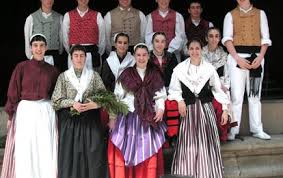 each region. Baseritarra is amongst the popular country outfits. Women wear a long red skirt with a black apron on the top, a white shirt, and a headscarf of the same color. On the other hand, men wear white shirts, and trousers, red belts, and the typical txapela on their heads.
each region. Baseritarra is amongst the popular country outfits. Women wear a long red skirt with a black apron on the top, a white shirt, and a headscarf of the same color. On the other hand, men wear white shirts, and trousers, red belts, and the typical txapela on their heads.
- Hereu and pubilla (Cataluna)
The traditional dress of Cataluna is Tratge De Hereu for men and Tratge De Pubilla for women. The dress is inclusive of ‘barretina’ woolen long cap usually of purple and red color, and ‘faixa’ a wide belt for men, and ‘ret’ net veil over the head of women. The most popular footwear is Espardenya.
Traditional Embroidery of Spain
Blackwork is a traditional and eminent embroidery work of Spain commonly known as Spanish Blackwork. It is a very old form of counted thread embroidery usually stitched or even weave fabric. It is generally a form of embroidery using black thread although other colors can be used on occasion. In spite of the name blackwork, it is done in blue, green, gold, and silver. Blackwork embroidery was done on primary fabrics like cotton or linen used for costume adornment such as shirt cuff. Initially, Blackwork counted stitches are worked to make a geometric or small floral pattern. It was traditionally done in a monochromic theme so that the thread and fabric need to contrast. Now Blackwork features large designs of flowers and other patterns connected by curvilinear stems. The stitches used for counted thread blackwork a double running, backstitch, and sometimes stem stitch.
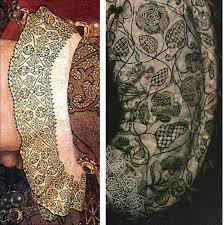
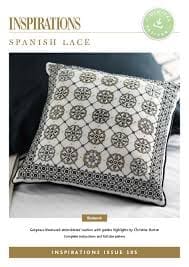
Spanish Dance Forms
From the Gypsy community of the south to the Celtic Heritage in the north, the cultural diversity of Spain is excellently encapsulated in its traditional dance forms.
- Sardana – Sardana dance form performed by a circle of alternative men and women holding hands and dance in Rhythm to a live band called Cobla. The dances performed at the celebrations and public gatherings and symbolize Catalan identity.
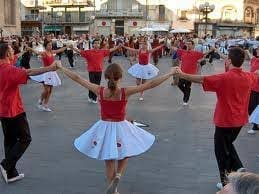
- Flamenco – Flamenco is much more than a dance and is recognized as a masterpiece of the oral and intangible heritage of humanity by UNESCO. It is transpired from the Gypsy community of Andalusia and is performed by singing, guitar playing, dancing, finger-snapping, and hand clapping.

- Muineria – Dance form has found its origin in the North-Western region of Galicia and has a Celtic influence. For performing this dance there is a use of bagpipe known as Gaita to perform the accompanying music.
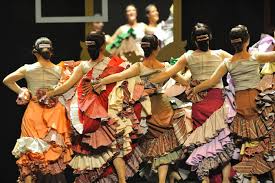
- Paso Doble – This is a fast-paced dance form based on the rhythm and movement of the bullfight. Similar to the ballroom, Paso Doble is also performed in pair with one man and a woman, with the former known to represent the Matador or bullfighter.
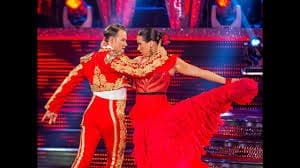
- Bolero – Bolero is a dance form found in Cuba and Spain. Bolero has emerged as a blend of existing dance forms the Sevillana and the Contradanza. The dance is accompanied by guitar music and castanets and is either performed solo or by a couple.
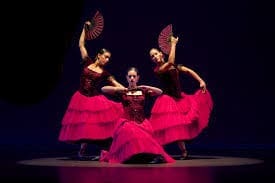
Traditional Spanish Cuisine
- Tortilla Espanola – As a Swedish cuisine, it is a thin bread made from flour. It is a Spanish omelet made of eggs and potatoes varying according to the traditional families and the regional recipes.
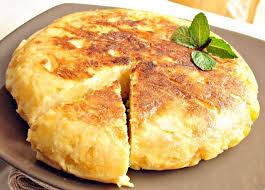
- Gambas al ajillo – It is an appetizer and finger food with garlic shrimps fried with olive oil in a special clay pot.

- Albondigas – It is a Spanish Meatballs similar to the worldwide famous Swedish Meatballs and is usually served with spicy tomato sauce.
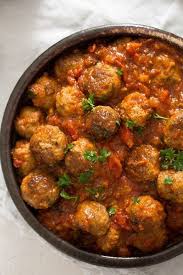
- Pulpo a la Gallega – This is a traditional dish from the region of Galicia where Galician Octopus is served with sliced cooked potatoes, olive oil, and smoked paprika.
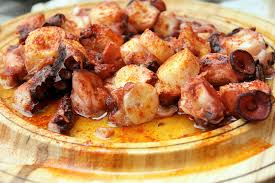
- Jamon Serrano and Iberico – It is a type of cured ham produced in Spain and Portugal and are of various standards and pricing according to the quality and age. It is commonly served on a platter but could be tried with melon.

- Mallorquin Tumbet – Tumbet is mouth-watering Spanish vegetarian food. This traditional dish has its origin from the Spanish island of Mallorca. It is meet it by the layers of sliced potatoes, red bell peppers, and aubergines fried in olive oil.
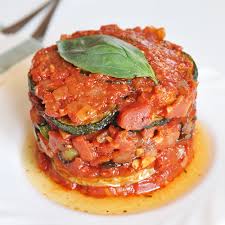
.jpg?lossy=2&strip=1&webp=1)
Tip: If you are interested in Hispanic culture, you can also try to experience it by purchasing accessories or clothing in the traditional styles or symbols of their culture. If you are more creative, you can also add your own creativity in designing brand new fashion patterns in their culture. These designs can be made into accessories such as Custom Pins , custom keychains or patches. They can be worn as a personalized fashion statement or as a unique souvenir of who you are.
Article Written By-
Naina Rupani, Management Trainee-TVC
FOSTIIMA Business School
navyarupani09@gmail.com

